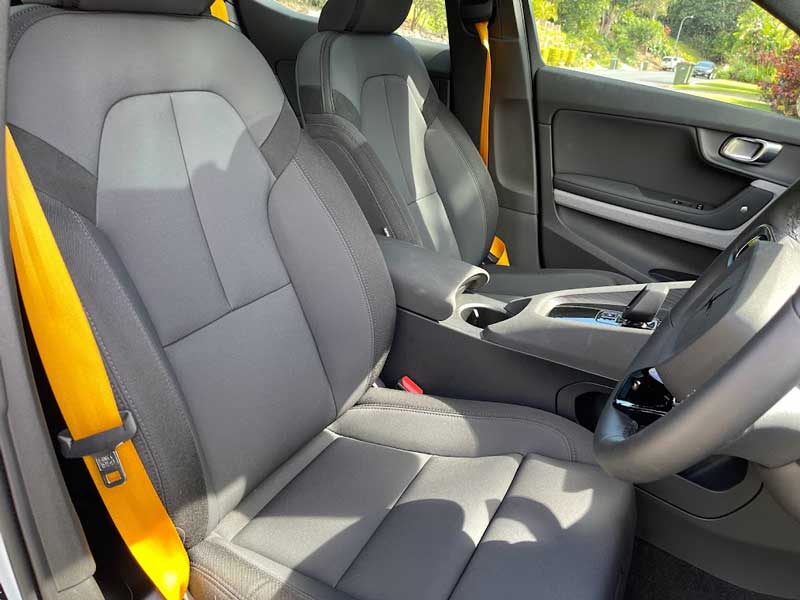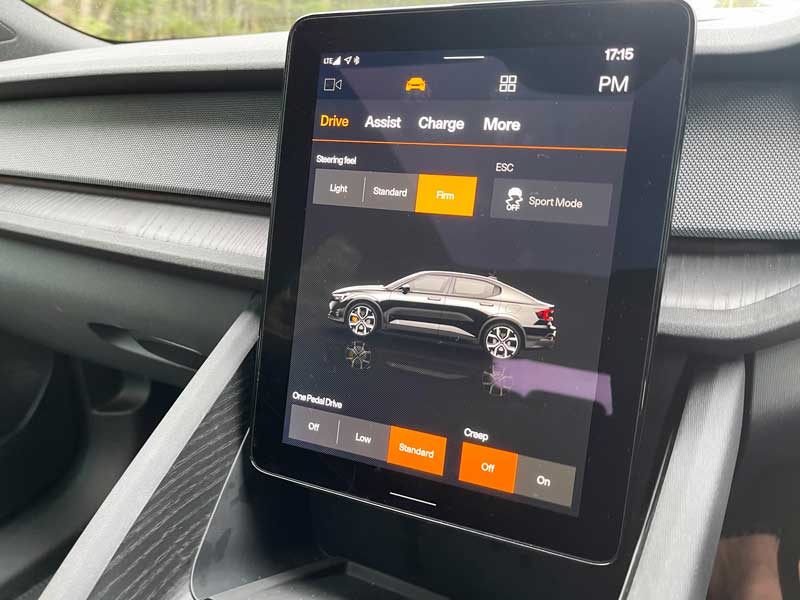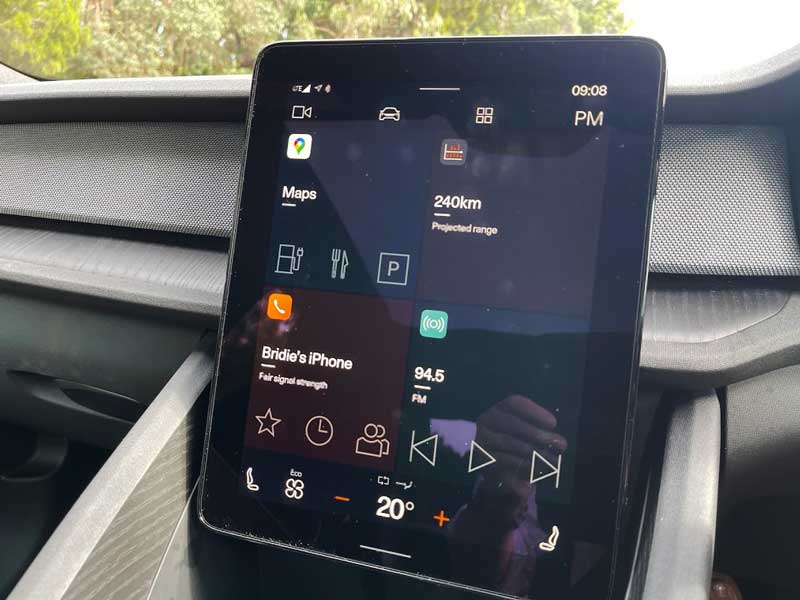The Polestar 2 is the first vehicle from Swedish-based Polestar to come to Australia. And while some may confuse the sound of the name with the Pulsar from the Japanese car maker Nissan, the two cars could hardly be more diferent.
Polestar 2 is the first all-electric model from what was initially described as a performance sub-brand of Volvo and its Chinese owner Geely to a fully-fledged all-electric marque. And it’s so good it is perhaps the first electric car to reach Australia that can truly be lauded with the title of “Tesla rival”.
It is available in three variants (single-motor standard range variant, single-motor long-range and dual-motor long-range, which is the one I’ve tested). And while Polestar says it is fully aware of the comparisons to the Tesla Model 3, it is ICE (internal combustion engine) drivers they want to impress.
And after driving the dual-motor long range model for the better half of a week, I can comfortably say that it will achieve both. It sizes up fairly well to the Californian pioneer’s mass-market sedan, and impressed those in my life who are not so much EV-hesitant, as just waiting for the right model to sweep them off their feet.

The Polestar 2 has a starting price of $59,900: this is equal to the Model 3, but with one caveat: while the Model 3 comes with Autopilot as standard, with Polestar the Pilot assist feature is a $5,000 add on, including adaptive cruise control and lane-keeping and other features such as blind-spot and cross-traffic alerts.
I find this a little confusing because as a sister brand to Volvo, I would have thought that safety assist features were first and foremost inclusions.
There are two other packages: the $8,000 Performance package which this vehicle clearly has included – the gold Brembo brakes stand out from a distance, and Öhlins dampers which are beautifully apparent when you experience the softness of the bumps going over potholes.
The third package is the $6,000 Plus package which includes panoramic sunroof, heatpump, and power seats with memory (again, all things the SR+ comes with standard). A full list of package inclusions can be found here.

At first glance, the Polestar 2 has a really compact fastback style body with a really solid stance to it. At least three friends who don’t own EVs already immediately gasped: “I think I like that!” when they first saw it. Or something to that effect.
Driving it, it feels safe and although it’s got plenty of power when you put the foot down, this Volvo DNA has led polestar to add some softened edges to the handling of the car: there are no sudden take-offs that you get with the Tesla, leaving the impression that the Polestar 2 is permanently in chill mode.
That doesn’t mean it isn’t a fun ride. On a roundabout it hugs the curve nicely and there’s no feeling of having to slow down excessively to keep the centre of gravity of the car from spinning out too far.
When needed, the car does has plenty of oomph – you just need to let it know by pressing the accelerator down far enough. Those that have ridden with me in the Tesla Model 3 SR+ and complained about the sudden start (I don’t drive in chill mode unless requested!) were well pleased by the Polestar’s more polite starts.
Drive modes
The controls of the Polestar 2 are all accessible through a vertically oriented touchscreen on the centre of the dash.
If you hit a little car icon at the top you get to choose from drive options which include steering from light to standard to firm, and it goes one up on my Tesla by offering you can choose between high recuperation braking which gives the full one-pedal experience, or low for less regen, or none.
The high regen mode isn’t jerky or annoying, and as I already love one pedal driving I leave it on that.
Good to see is the inclusion of Creep mode – which Polestar tells me is available as standard on all variants including the Standard range single-motor (it isn’t on the Tesla Model 3 SR+).

Pilot Assist
Next tab on the touchscreen is Driver Assist, which in this vehicle includes the features mentioned in the Pilot package above.
It took me a little while to figure out how to turn on the Pilot Assist – tap the cruise control and the right button – at which time the car icon in the driver’s display turns yellow.

It works as you would expect – it adapts the car’s speed and keeps it in the lanes, although it seems to need quite high contrast in the lines on the road to be able to turn it on.
Also, you have to put the foot on the brake to run it off. If you give the steering wheel a good nudge it doesn’t disengage; instead you’re actually able to steer the Polestar a little, and if you go out of the lane you’ll get a subtle vibration.
Charging
Next tab to the right is charging. Unfortunately I wasn’t able to test fast-charging – a fault meant it would only charge at a very low rate, the reason for which will have to be determined when it returns to Polestar. Polestar’s spokesperson assured me she’d charged her vehicle at a similar charger recently so it was just pure bad luck the vehicle I reviewed had a problem.
Charging at home was as simple as plugging your phone in. However, because Polestar hasn’t turned on the smartphone app for Australia yet, I had no feedback on how long the charge would take, which was a shame, but won’t affect customers who Polestar assures will have access to the app from purchase.

Google apps
On the top of the screen are four little white boxes, where you can access Android Automotive integration that is a step up from Android Auto. Whereas Android Auto is a phone mirroring system so you connect to cut your phone to the car via Bluetooth, Android Automotive is a dedicated and integrated automotive experience developed in partnership between Polestar and Google.
Polestar says it chose Google as a partner because of Google Assistant’s lead in the automation market. Certainly, there was no problem understanding my Australian accent – something the Tesla does have a problem with.
While developers will be able to use Google’s Android open source code to develop apps for the Polestar 2 there aren’t that many available yet other than a variety of radio stations. Polestar says A Better Route Planner has been developed for this car but perhaps it’s not been activated yet for Australia.
The vehicle comes with a number of pre-installed apps, including Spotify, Radio, and range Assistant among others. More will become available as time goes on, but for now the most interesting is Range Assistant, which Polestar has developed in-house.
Driving range
Although Polestar advises the 2 should only be charged to 90% for maximum battery longevity, I start with the maximum to see how the 78kWh lives up to a WLTP promise of 470km range.
When it’s charged to 100% the range of the car says it’s got 400 km range: it has to be mentioned that with a maximum 2.113 kerb weight and drag coefficient of 0.278Cd, this car is not going to be the most efficient on the market.

Range Assistant gives live feedback on the projected driving range and ccurrent energy usage. The way I’ve been driving I’m told the car (which the driver display says has 380km range left and 94% battery), I apparently really have 360km range left.
It also gives me real-time feedback on how much power I’m using: cruising along at 60km I’m using about 21-23 kWh/100km.
Climate control
Swipe up from the little white line at the bottom of the screen to find access to the latest four apps you’ve opened as well as climate control via a fan icon at the bottom of the screen.

There, you can access settings for recirculation, rear defroster, max defroster am and also how strong the fan is, and whether it is pointing to the windscreen, the driver or the feet (or some combination of that).
Also, there are seat heating options, with plenty of space between other settings so you don’t accidentally turn them on (this is a well-documented issue with the Tesla!).
Final thoughts
Of all the EVs I’ve driven I think this is the one I want to succeed the most. While the Californian cockroach (the nickname given to the Tesla Model 3 now that they are everywhere) might not appeal to those after a more traditional automotive design, the Polestar packs enough punch to impress and has plenty of eye-catching appeal.
However, it must be noted the Performance’s 4.7 second acceleration is much quicker than the standard 7.4 seconds in the non-Performance versions, and I can’t help but wonder if the 61kWh standard-range battery will live up to expectations. According to EV-Database is will still do 350km in real-world conditions, using an average of 17.4kWh/100km.
The seats are comfortable and I like that although it is essentially a compact fastback, it is higher off the ground than my white sedan. I also like that it has a hatch back as opposed to a boot, which means no leaning down to get packages out of the back. There is a nifty lift-up piece in the rear to secure precious cargo, as well as a frunk (although why this is carpeted is beyond me).

Cool little design thoughts like the gear shift in the centre console and the little Polestar logo that shines on the panoramic roof at night give the vehicle an air of futuristic cool.
Add to that its chilled attitude and it will be sure to break through the ICE.
Update: The Polestar 2 is expected to become available for order in late 2021 with first deliveries in 2022.

Bridie Schmidt is associate editor for The Driven, sister site of Renew Economy. She has been writing about electric vehicles since 2018, and has a keen interest in the role that zero-emissions transport has to play in sustainability. She has participated in podcasts such as Download This Show with Marc Fennell and Shirtloads of Science with Karl Kruszelnicki and is co-organiser of the Northern Rivers Electric Vehicle Forum. Bridie also owns a Tesla Model Y and has it available for hire on evee.com.au.

